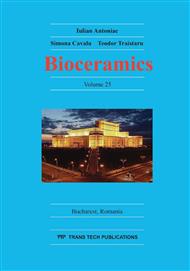[1]
Park JH, Olivares-Navarrete R, Wasilewski CE, Boyan BD, Tannenbaum R, Schwartz Z. Use of polyelectrolyte thin films to modulate osteoblast response to microstructured titanium surfaces. Biomaterials. 2012; 33: 5267-77.
DOI: 10.1016/j.biomaterials.2012.03.074
Google Scholar
[2]
Gittens RA, McLachlan T, Olivares-Navarrete R, Cai Y, Berner S, Tannenbaum R, et al. The effects of combined micron-/submicron-scale surface roughness and nanoscale features on cell proliferation and differentiation. Biomaterials. 2011; 32: 3395-403.
DOI: 10.1016/j.biomaterials.2011.01.029
Google Scholar
[3]
Zhao L, Liu L, Wu Z, Zhang Y, Chu PK. Effects of micropitted/nanotubular titania topographies on bone mesenchymal stem cell osteogenic differentiation. Biomaterials. 2012; 33: 2629-41.
DOI: 10.1016/j.biomaterials.2011.12.024
Google Scholar
[4]
Wennerberg A, Albrektsson T. Effects of titanium surface topography on bone integration: a systematic review. Clinical oral implants research. 2009; 20 Suppl 4: 172-84.
DOI: 10.1111/j.1600-0501.2009.01775.x
Google Scholar
[5]
Anselme K, Davidson P, Popa AM, Giazzon M, Liley M, Ploux L. The interaction of cells and bacteria with surfaces structured at the nanometre scale. Acta biomaterialia. 2010; 6: 3824-46.
DOI: 10.1016/j.actbio.2010.04.001
Google Scholar
[6]
Bettinger CJ, Langer R, Borenstein JT. Engineering substrate topography at the micro- and nanoscale to control cell function. Angew Chem Int Ed Engl. 2009; 48: 5406-15.
DOI: 10.1002/anie.200805179
Google Scholar
[7]
Neoh KG, Hu X, Zheng D, Kang ET. Balancing osteoblast functions and bacterial adhesion on functionalized titanium surfaces. Biomaterials. 2012; 33: 2813-22.
DOI: 10.1016/j.biomaterials.2012.01.018
Google Scholar
[8]
Zhao L, Wang H, Huo K, Cui L, Zhang W, Ni H, et al. Antibacterial nano-structured titania coating incorporated with silver nanoparticles. Biomaterials. 2011; 32: 5706-16.
DOI: 10.1016/j.biomaterials.2011.04.040
Google Scholar
[9]
Hong Y, Yu M, Weng W, Cheng K, Wang H, Lin J. Light-induced cell detachment for cell sheet technology. Biomaterials. 2013; 34: 11-8.
DOI: 10.1016/j.biomaterials.2012.09.043
Google Scholar
[10]
Chan HM, Xiao L, Yeung KM, Ho SL, Zhao D, Chan WH, et al. Effect of surface-functionalized nanoparticles on the elongation phase of beta-amyloid (1-40) fibrillogenesis. Biomaterials. 2012; 33: 4443-50.
DOI: 10.1016/j.biomaterials.2012.03.024
Google Scholar
[11]
Hong Y, Cheng K, Weng W, Song C, Du P, Shen G, et al. Low temperature preparation of TiO2 nanodot film on substrates. Thin Solid Films. 2011; 519: 4641-6.
DOI: 10.1016/j.tsf.2011.01.009
Google Scholar
[12]
Li L, Liu C-y. Organic small molecule-assisted synthesis of high active TiO2 rod-like mesocrystals. CrystEngComm. 2010; 12: (2073).
DOI: 10.1039/b924170a
Google Scholar


